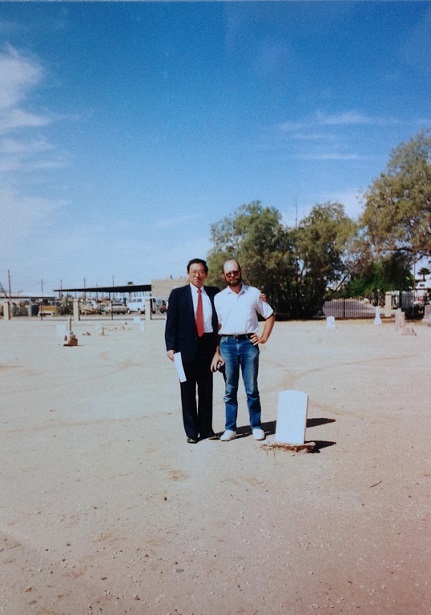1992年清明时节,美国人考古学家K. J. 施罗德(K. J. Schroeder)邀请我和他一起到凤凰城先民和军人纪念墓园(Pioneer and Military Memorial Park)考察华人墓葬和清明节扫墓习俗。那次我们确认了墓园里唯一的一块邓湘远中文墓碑。
施罗德问了我好多有关华人扫墓的问题,我详细地向他讲述了清明节华人扫墓的风俗习惯。1994年施罗德主编Pioneer and Memorial Park Archaeological Project in Phoenix Arizona 1990-1992,在该书第二卷的第三章和第十七章里,记录下我的讲述。下面是摘录。
1992年4月5日,唐孝先(William Tang)(左)和K. J. Schroeder (右)合影于邓湘远中文墓碑旁。

Another annual event is the Pure Brightness Ceremony, a Chinese traditional occasion honoring the dead. This ceremony usually occurs on April 5. For a couple of years it was puzzling to the PCA(Pioneers?Cemetery Association) members when they arrived to work at the cemetery, as to who was burning incense and wax candles in front of the gates at P&MMP(Pioneer and Military Memorial Park). The mystery was solved when William Tang, a visiting scholar from China, was asked to interpret the Chinese characters on a tombstone at City Cemetery. From him, it was learned that the Pure Brightness Ceremony is performed by the descendants of the dead, and serves to prevent evil spirits from entering the cemetery site. The PCA has since then made every effort to have the cemetery gates open to the Chinese for the Pure Brightness Ceremony.
The members of the Pioneers?Cemetery Association (PCA) had, for a number of years, been puzzled by the occasional presence of ashes, melted candles, and partially burned, thin sticks found at the gates of the cemeteries at the Pioneer & Military Memorial Park (P&MMP). These items were found at temporarily isolated intervals, i. e., once every spring, and would be present when PCA members of the arrived to work at the cemeteries. Another puzzle was the interpretation of the Chinese characters on a tombstone at the P&MMP. This tombstone is located within what has come to be known as the Chinese Circle and is part of City Cemetery.
In an effort to have the inscription on the tombstone interpreted, the senior author invited William Tang, a visiting Chinese scholar at Arizona State University, to the cemeteries. The results of Tang’s interpretation and additional studies into the history of the individual buried there will be presented under separate title. However, as a spin off of this investigation, the mystery of the first puzzle was solved.
According to Tang, the materials found at the entries to the cemeteries resulted from an ancient Chinese ceremony in honor of the dead known as the Pure Brightness Festival, or Qing Ming. The remains found were the burned remnants of paper money, hand made wax candles, and sticks of incense.
打开微信扫一扫
点击右上角分享
此文章到朋友圈




